
Norbury, Derbyshire
Encyclopedia
Norbury is a village in Derbyshire
, England
. It is located 3 miles (4.8 km) north of Rocester
, on the B5033 road and the River Dove
(which is the traditional border for Staffordshire
). The hamlet has links with George Eliot
's family, the Evans. George Eliot's father, Robert Evans, was born in Roston Common and sang in the choir at Norbury church, and most of George Eliot's paternal ancestors are buried there.
The ecclesiastical parish of Norbury includes Norbury, Roston
, the parochial chapel and manor of Snelston
, the hamlets of Birchwood and Darley Moor, and formerly included the liberty of Stydd, now in Yeaveley
.
A Methodist chapel stood where Chapel Farm, by the Queen Adelaide Inn, is now. Dinah Morris (based on George Eliot’s aunt, Elizabeth Evans) preached here. Eliot’s father Robert was a carpenter at Norbury, and became a land agent here- he moved with his employer to Arbury
, where Eliot was born to his second wife. Eliot’s own connections with Norbury were slight- “As to my indebtedness to facts of locale- the details which I knew as facts and have made use of for my picture were gathered from such imperfect allusion and narrative as I heard from my father in his occasional talk about old times.” The carpenter’s shop at Norbury was associated with the smell of pinewood
and the scent of elderflower; Eliot said to Oscar Browning
that the elder tree growing at the door of the workshop was an early recollection closely connected with the poetry of her life.
The graveyard contains the graves of Thias and Lisbeth Bede.
, in 1086, together with Roston
, amongst the many manors given to Henry de Ferrers
by William the Conqueror. The village was spelt Nordberie or Nortberie. At that time the village had a church and a mill.
Norbury Manor was given to Henry de Ferrers in 1081, the previous Saxon
owner Sweyn having been dispossessed and imprisoned for his part in the uprising of Hereward the Wake
. Henry founded a priory at Tutbury and gave Norbury to them. In 1125 the prior of Tutbury gave Norbury in fee-farm to William Fitzherbert on a yearly rental of 100 shillings. In 1442 Nicholas Fitzherbert and his son and heir Ralph
gave all their lands at Osmaston
and other lands at Foston
and Church Broughton
in exchange for Norbury. The Fitzherberts held it until 1872.
The village steadily declined in population throughout the 19th and 20th centuries. In 1841 the population of Norbury and Roston
was 510, in 1895 there were 414 inhabitants. By 1935 there were 365 villagers, decreasing further to an estimated 315 in 1951. According to the 2001 census the population was 270.
was born in Rosliston
or Norbury in 1761. About 1788 she went to Tutbury
, where in 1807 she declared that she could live without food. Exhibiting herself to the paying public whilst lying in her bed holding a bible earned her about £240 (or £14,000 in today's (2008) money, and also attracted the attentions of medical men and ministers of the church. After some prevarication she agreed to be watched continually, which arrangement lasted a week by which time she was so debilitated that the watchers agreed for her daughter to visit her alone. Afterwards traces of food were found on her clothes and bed, but it was not until 1813 that she confessed to the deception.
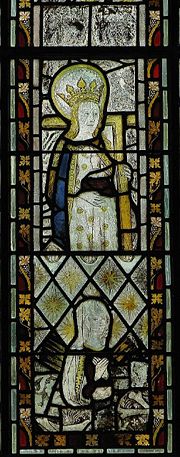
 The present church is the third one on this site, the first being Anglo-Saxon and the second a Late Norman church. This second church was built c. 1179 by John Fitzherbert, 3rd Lord of Norbury and dedicated to St Barlacus. The saint appears in the centre light of the south window; he is portrayed holding a pastoral staff in his left hand and a book in his right. Underneath there are the words Sactus Burlok Abbas. The name also appears as Saint Barlok in a 1491 charter.
The present church is the third one on this site, the first being Anglo-Saxon and the second a Late Norman church. This second church was built c. 1179 by John Fitzherbert, 3rd Lord of Norbury and dedicated to St Barlacus. The saint appears in the centre light of the south window; he is portrayed holding a pastoral staff in his left hand and a book in his right. Underneath there are the words Sactus Burlok Abbas. The name also appears as Saint Barlok in a 1491 charter.
Saint Barlock has been identified with Saint Finbarr, an Irish abbot and bishop of the 7th century and the patron saint of Cork. The dedication may arise from John Fitzherbert having been Governor of Waterford
for 3 years c. 1174. Born in the second half of the 6th century, Finnbar was baptised Lochan, but was later called Fionn Barr or the Fair-Headed One. His life was recorded in the manuscript Lives of Finn Barr. The parish church of Fowey
in Cornwall
is dedicated to him, as St Fimbarrus. This Cornish church was built c. 1170 by William Fitzturold, the name of the patron saint being given as Barrianus.
The present church of St Mary and St Barlock was built piecemeal over a period of about 200 years. The chancel
is the earliest part of the church, and is unusually large in relation to the rest of the fabric. It is 46 feet (14 m) long, and is both wider and higher than the nave
(which at 49 feet (14.9 m) is slightly longer). The design of the chancel windows’ tracery
indicates a building date of c. 1300-1310, as does the contemporary armorial glass. Two of the arms depicted are those of Otton de Grandson
who left England in 1307, and Robert the Bruce, at war with England from 1306. The roof of the chancel is a later 15th century wooden construction; external buttresses and internal shafts running up to the roof line indicate that the original design may have intended a fan vault, never built.
The south tower, nave and chapel east of the tower were built by Nicholas Fitzherbert (d. 1473), he or his son Ralph (d. 1483) built the north aisle, and his grandson John Fitzherbert (d. 1513) built the south-west chapel, which was finished in 1517. Much of the stained glass added by the Fitzherberts survives; these are for the most part figures painted in grisaille
. In the south-east chapel there is a window showing the donor and his family.
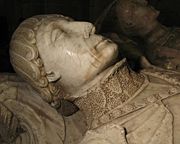
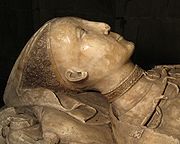
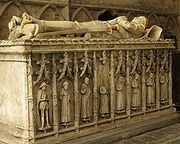
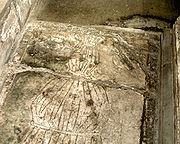 There are a number of memorials to the Fitzherbert family in the church, including Sir Henry (d. 1315) depicted as a cross-legged knight, Nicholas (d. 1473) carved in alabaster
There are a number of memorials to the Fitzherbert family in the church, including Sir Henry (d. 1315) depicted as a cross-legged knight, Nicholas (d. 1473) carved in alabaster
with attendant mourners, and Sir Ralph Fitzherbert
(d. 1483) and his wife, again in alabaster.
The crossed legs of Henry, 6th Lord of Norbury c. 1275- c. 1315 indicate his profession of Christian faith and not participation in a Crusade; although his year of death is uncertain it is known that he was not a Crusader
Nicholas Fitzherbert, High Sheriff
of Derbyshire and 11th Lord of Norbury died in 1473. He is shown in full plate armour with a collar of alternating suns and roses with a pendant of the White Lion of the House of Marche, the badge of Edward IV. There is a small angel supporting his right foot.
Ralph’s feet rest on a lion; next to it and under Ralph’s shoe crouches the small figure of a bedesman. The bearded bedesman is telling his rosary
for the souls of the departed. Ralph bears the Yorkist livery collar of alternating suns and roses, with the White Boar of Richard III
as a pendant. Since the destruction of the effigy of Ralph Neville
(d. 1484) at Brancepeth
, this is the only surviving representation of a boar pendant.
The armour
portrayed on the effigy of Ralph Fitzherbert has been reproduced as a fully functional suit of plate.
An incised effigy on an alabaster slab of a woman tied in a shroud has been identified as that of Benedicta (d. 1531) wife of John Fitzherbert, 13th Lord. The effigy is surrounded with four coats of arms, one of which is of the Bradbourne family of Benedicta. Above the figure is a worn inscription with the date 1531.
John Fitzherbert separated from Benedicta early in their marriage. In his will he disinherited Benedicta and denied paternity of her children, stating “…Bennett my wyffe hath been of lewd and vile disposicion and cowde not be content with me but forsaken my houshoolde and company and lyffed in other places where yt pleased her.”
The great east window of the chapel originally held 14th century glass depicting a large scene with full-sized figures. By 1770 the glass was in very bad condition. At that time the rectors of parishes were personally responsible for the financing of repairs to their churches- so the rector of Norbury, the Rev. S. Mills, had the window bricked up with the glass remaining in situ. In 1830 the then rector, the Rev. Thomas Bingham, was approached by a Roman Catholic family of Yorkshire
with a view to purchasing the glass. Whether the glass was removed and sold, or stolen (as happened at Haddon Hall
), or had disintegrated is not known, but it had disappeared by 1842 when the window was opened up again and filled with 15th century glass taken from the rest of the church windows.
A notable member of the FitzHerbert family was the judge Sir Anthony Fitzherbert
. The manor fell into disuse in the 16th century when Sir John FitzHerbert married Ann Eyre and moved to Padley Hall.
Norbury Manor is now owned by the National Trust, and occupied by tenants who maintain the Hall and Gardens. Visitors are welcome to tour the old Hall and gardens on two specific days each week from April to October. (Fri 11:00 to 13:00, Sat 14:00 to 16:00).
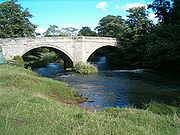 Norbury Mill is a stone building of 2 storeys, 85 feet (25.9 m) long and 25 feet (7.6 m) wide. It is probably of 17th century construction; it has a datestone inscribed WB 1736. The mill is fed from a leat ½ mile in length flowing from a weir on the River Dove. There are two wheels, both low breastshot, at the south and north ends of the mill. In 1809 the mill had 3 pairs of millstones for grinding corn. Milling appears to have ceased in 1928, although it may have resumed later. In 1932 a saw mill and generating dynamo were added by the estate of Norbury Hall, both being driven by the waterwheels. The last miller, Sam Wheeldon, finished in 1955.
Norbury Mill is a stone building of 2 storeys, 85 feet (25.9 m) long and 25 feet (7.6 m) wide. It is probably of 17th century construction; it has a datestone inscribed WB 1736. The mill is fed from a leat ½ mile in length flowing from a weir on the River Dove. There are two wheels, both low breastshot, at the south and north ends of the mill. In 1809 the mill had 3 pairs of millstones for grinding corn. Milling appears to have ceased in 1928, although it may have resumed later. In 1932 a saw mill and generating dynamo were added by the estate of Norbury Hall, both being driven by the waterwheels. The last miller, Sam Wheeldon, finished in 1955.
's branch line to Ashbourne
at Norbury and Ellaston railway station
and this continued until 1952 (and 1954 for freight traffic).
own the "Old Manor". The village has a Church of England primary school called Norbury School. although there are only 36 students in some school years for Norbury ward.
Generally the population is less economically active than the East Midlands in general, but are in better health. The prevailing religion is Christian (86%) with "no religion" as the second highest choice (5.5%).
July 2010: The parishioners of Norbury Church are holding an event to mark the 700th anniversary of the church. Go to for more information.
Derbyshire
Derbyshire is a county in the East Midlands of England. A substantial portion of the Peak District National Park lies within Derbyshire. The northern part of Derbyshire overlaps with the Pennines, a famous chain of hills and mountains. The county contains within its boundary of approx...
, England
England
England is a country that is part of the United Kingdom. It shares land borders with Scotland to the north and Wales to the west; the Irish Sea is to the north west, the Celtic Sea to the south west, with the North Sea to the east and the English Channel to the south separating it from continental...
. It is located 3 miles (4.8 km) north of Rocester
Rocester
Rocester is a village and civil parish in the East Staffordshire district of Staffordshire, England. Its name is spelt Rowcestre in the Domesday Book.-Geography:...
, on the B5033 road and the River Dove
River Dove, Derbyshire
The River Dove is the principal river of the southwestern Peak District, in the Midlands of England and is around in length. It rises on Axe Edge Moor near Buxton and flows generally south to its confluence with the River Trent at Newton Solney. From there, its waters reach the North Sea via the...
(which is the traditional border for Staffordshire
Staffordshire
Staffordshire is a landlocked county in the West Midlands region of England. For Eurostat purposes, the county is a NUTS 3 region and is one of four counties or unitary districts that comprise the "Shropshire and Staffordshire" NUTS 2 region. Part of the National Forest lies within its borders...
). The hamlet has links with George Eliot
George Eliot
Mary Anne Evans , better known by her pen name George Eliot, was an English novelist, journalist and translator, and one of the leading writers of the Victorian era...
's family, the Evans. George Eliot's father, Robert Evans, was born in Roston Common and sang in the choir at Norbury church, and most of George Eliot's paternal ancestors are buried there.
The ecclesiastical parish of Norbury includes Norbury, Roston
Roston
Roston is a hamlet in Derbyshire, England. It is located north of Rocester. The Roston Inn is at the junction of Mill Lane and Lid Lane in the hamlet. Roston is in the parish of Norbury with Roston....
, the parochial chapel and manor of Snelston
Snelston
Snelston is a village and civil parish three miles south-west of Ashbourne in Derbyshire. It includes Anacrehill. A tributary of the River Dove flows through its centre....
, the hamlets of Birchwood and Darley Moor, and formerly included the liberty of Stydd, now in Yeaveley
Yeaveley
Yeaveley is a small village near Rodsley and 4 miles south of Ashbourne in Derbyshire.The village has no school but does have a public house and the Holy Trinity Church...
.
A Methodist chapel stood where Chapel Farm, by the Queen Adelaide Inn, is now. Dinah Morris (based on George Eliot’s aunt, Elizabeth Evans) preached here. Eliot’s father Robert was a carpenter at Norbury, and became a land agent here- he moved with his employer to Arbury
Arbury
Arbury is a district and electoral ward of the city of Cambridge, England. The ward borders the following other wards : Histon, King's Hedges, West Chesterton, Market and Castle.-History:...
, where Eliot was born to his second wife. Eliot’s own connections with Norbury were slight- “As to my indebtedness to facts of locale- the details which I knew as facts and have made use of for my picture were gathered from such imperfect allusion and narrative as I heard from my father in his occasional talk about old times.” The carpenter’s shop at Norbury was associated with the smell of pinewood
Pinewood
Pinewood may refer to:* Pine, a species of tree* Pinewood Studios, a major British film studio in Buckinghamshire-Places:in England* Pinewood, Suffolkin the United States* Pinewood, Florida* Pinewood, Minnesota...
and the scent of elderflower; Eliot said to Oscar Browning
Oscar Browning
Oscar Browning was an English writer, historian, and educational reformer. His greatest achievement was the cofounding, along with Henry Sidgwick, of the Cambridge University Day Training College in 1891...
that the elder tree growing at the door of the workshop was an early recollection closely connected with the poetry of her life.
The graveyard contains the graves of Thias and Lisbeth Bede.
History
Like many places in Derbyshire, Norbury was mentioned in the Domesday BookDomesday Book
Domesday Book , now held at The National Archives, Kew, Richmond upon Thames in South West London, is the record of the great survey of much of England and parts of Wales completed in 1086...
, in 1086, together with Roston
Roston
Roston is a hamlet in Derbyshire, England. It is located north of Rocester. The Roston Inn is at the junction of Mill Lane and Lid Lane in the hamlet. Roston is in the parish of Norbury with Roston....
, amongst the many manors given to Henry de Ferrers
Henry de Ferrers
Henry de Ferrers was a Norman soldier from a noble family who took part in the conquest of England and is believed to have fought at the Battle of Hastings of 1066 and, in consequence, was rewarded with much land in the subdued nation.His elder brother William fell in the battle. William and Henri...
by William the Conqueror. The village was spelt Nordberie or Nortberie. At that time the village had a church and a mill.
Norbury Manor was given to Henry de Ferrers in 1081, the previous Saxon
Anglo-Saxons
Anglo-Saxon is a term used by historians to designate the Germanic tribes who invaded and settled the south and east of Great Britain beginning in the early 5th century AD, and the period from their creation of the English nation to the Norman conquest. The Anglo-Saxon Era denotes the period of...
owner Sweyn having been dispossessed and imprisoned for his part in the uprising of Hereward the Wake
Hereward the Wake
Hereward the Wake , known in his own times as Hereward the Outlaw or Hereward the Exile, was an 11th-century leader of local resistance to the Norman conquest of England....
. Henry founded a priory at Tutbury and gave Norbury to them. In 1125 the prior of Tutbury gave Norbury in fee-farm to William Fitzherbert on a yearly rental of 100 shillings. In 1442 Nicholas Fitzherbert and his son and heir Ralph
Ralph Fitzherbert
Ralph Fitzherbert was Lord of the manor of Norbury, Derbyshire. His effigy in his suit of armour at Norbury church are reproduced in the Victoria and Albert Museum, in contemporary armour. -Biography:...
gave all their lands at Osmaston
Osmaston
Osmaston may refer to:Placenames*Osmaston, Derby, England** where Osmaston Hall was*Osmaston, Derbyshire Dales** where Osmaston Manor wasPeople* Bertram Beresford Osmaston CIE...
and other lands at Foston
Foston, Derbyshire
Foston is a hamlet in the Foston and Scropton civil parish of South Derbyshire, Derbyshire, England, about west of Derby. The Domesday Book of 1086 lists it as Farulveston.-Foston Hall:...
and Church Broughton
Church Broughton
Church Broughton is a village and civil parish located in Derbyshire, just ten miles to the west of Derby. There is a church , a Methodist chapel and Church Broughton Primary School. Pupils from the school would then move on to John Port School in Etwall....
in exchange for Norbury. The Fitzherberts held it until 1872.
The village steadily declined in population throughout the 19th and 20th centuries. In 1841 the population of Norbury and Roston
Norbury with Roston
Norbury with Roston is a civil parish in west Derbyshire incorporating the villages of Norbury and Roston...
was 510, in 1895 there were 414 inhabitants. By 1935 there were 365 villagers, decreasing further to an estimated 315 in 1951. According to the 2001 census the population was 270.
Ann Moore
Ann (Pegg) MooreAnn Moore (imposter)
Ann Moore was an English woman who became notorious as the fasting-woman of Tutbury. From 1807 to 1813, she claimed to have eaten nothing at all, but her claims were eventually shown to be a hoax.-Life:...
was born in Rosliston
Rosliston
Rosliston is a small village in South Derbyshire, England close to the county boundaries of Leicestershire and Staffordshire.It is within The National Forest and just outside the village is the Rosliston Forestry Centre. The two village pubs are called "The Bulls Head " and "The Plough Inn". The...
or Norbury in 1761. About 1788 she went to Tutbury
Tutbury
Tutbury is a large village and civil parish of about 3,000 residents in the English county of Staffordshire.It is surrounded by the agricultural countryside of both Staffordshire and Derbyshire. The site has been inhabited for over 3000 years, with Iron Age defensive ditches encircling the main...
, where in 1807 she declared that she could live without food. Exhibiting herself to the paying public whilst lying in her bed holding a bible earned her about £240 (or £14,000 in today's (2008) money, and also attracted the attentions of medical men and ministers of the church. After some prevarication she agreed to be watched continually, which arrangement lasted a week by which time she was so debilitated that the watchers agreed for her daughter to visit her alone. Afterwards traces of food were found on her clothes and bed, but it was not until 1813 that she confessed to the deception.
The church


Saint Barlock has been identified with Saint Finbarr, an Irish abbot and bishop of the 7th century and the patron saint of Cork. The dedication may arise from John Fitzherbert having been Governor of Waterford
Waterford
Waterford is a city in the South-East Region of Ireland. It is the oldest city in the country and fifth largest by population. Waterford City Council is the local government authority for the city and its immediate hinterland...
for 3 years c. 1174. Born in the second half of the 6th century, Finnbar was baptised Lochan, but was later called Fionn Barr or the Fair-Headed One. His life was recorded in the manuscript Lives of Finn Barr. The parish church of Fowey
Fowey
Fowey is a small town, civil parish and cargo port at the mouth of the River Fowey in south Cornwall, United Kingdom. According to the 2001 census it had a population of 2,273.-Early history:...
in Cornwall
Cornwall
Cornwall is a unitary authority and ceremonial county of England, within the United Kingdom. It is bordered to the north and west by the Celtic Sea, to the south by the English Channel, and to the east by the county of Devon, over the River Tamar. Cornwall has a population of , and covers an area of...
is dedicated to him, as St Fimbarrus. This Cornish church was built c. 1170 by William Fitzturold, the name of the patron saint being given as Barrianus.
The present church of St Mary and St Barlock was built piecemeal over a period of about 200 years. The chancel
Chancel
In church architecture, the chancel is the space around the altar in the sanctuary at the liturgical east end of a traditional Christian church building...
is the earliest part of the church, and is unusually large in relation to the rest of the fabric. It is 46 feet (14 m) long, and is both wider and higher than the nave
Nave
In Romanesque and Gothic Christian abbey, cathedral basilica and church architecture, the nave is the central approach to the high altar, the main body of the church. "Nave" was probably suggested by the keel shape of its vaulting...
(which at 49 feet (14.9 m) is slightly longer). The design of the chancel windows’ tracery
Tracery
In architecture, Tracery is the stonework elements that support the glass in a Gothic window. The term probably derives from the 'tracing floors' on which the complex patterns of late Gothic windows were laid out.-Plate tracery:...
indicates a building date of c. 1300-1310, as does the contemporary armorial glass. Two of the arms depicted are those of Otton de Grandson
Otton de Grandson
Otto de Grandson was a medieval Savoyard knight long in the service of the English crown under Edward I. He was the closest personal friend of Edward, his exact contemporary, and shared the king's many interests....
who left England in 1307, and Robert the Bruce, at war with England from 1306. The roof of the chancel is a later 15th century wooden construction; external buttresses and internal shafts running up to the roof line indicate that the original design may have intended a fan vault, never built.
The south tower, nave and chapel east of the tower were built by Nicholas Fitzherbert (d. 1473), he or his son Ralph (d. 1483) built the north aisle, and his grandson John Fitzherbert (d. 1513) built the south-west chapel, which was finished in 1517. Much of the stained glass added by the Fitzherberts survives; these are for the most part figures painted in grisaille
Grisaille
Grisaille is a term for painting executed entirely in monochrome or near-monochrome, usually in shades of grey. It is particularly used in large decorative schemes in imitation of sculpture. Many grisailles in fact include a slightly wider colour range, like the Andrea del Sarto fresco...
. In the south-east chapel there is a window showing the donor and his family.
Fitzherbert memorials




Alabaster
Alabaster is a name applied to varieties of two distinct minerals, when used as a material: gypsum and calcite . The former is the alabaster of the present day; generally, the latter is the alabaster of the ancients...
with attendant mourners, and Sir Ralph Fitzherbert
Ralph Fitzherbert
Ralph Fitzherbert was Lord of the manor of Norbury, Derbyshire. His effigy in his suit of armour at Norbury church are reproduced in the Victoria and Albert Museum, in contemporary armour. -Biography:...
(d. 1483) and his wife, again in alabaster.
The crossed legs of Henry, 6th Lord of Norbury c. 1275- c. 1315 indicate his profession of Christian faith and not participation in a Crusade; although his year of death is uncertain it is known that he was not a Crusader
Nicholas Fitzherbert, High Sheriff
High Sheriff
A high sheriff is, or was, a law enforcement officer in the United Kingdom, Canada and the United States.In England and Wales, the office is unpaid and partly ceremonial, appointed by the Crown through a warrant from the Privy Council. In Cornwall, the High Sheriff is appointed by the Duke of...
of Derbyshire and 11th Lord of Norbury died in 1473. He is shown in full plate armour with a collar of alternating suns and roses with a pendant of the White Lion of the House of Marche, the badge of Edward IV. There is a small angel supporting his right foot.
Ralph’s feet rest on a lion; next to it and under Ralph’s shoe crouches the small figure of a bedesman. The bearded bedesman is telling his rosary
Rosary
The rosary or "garland of roses" is a traditional Catholic devotion. The term denotes the prayer beads used to count the series of prayers that make up the rosary...
for the souls of the departed. Ralph bears the Yorkist livery collar of alternating suns and roses, with the White Boar of Richard III
Richard III of England
Richard III was King of England for two years, from 1483 until his death in 1485 during the Battle of Bosworth Field. He was the last king of the House of York and the last of the Plantagenet dynasty...
as a pendant. Since the destruction of the effigy of Ralph Neville
Ralph Neville
Ralph Neville was a medieval clergyman and politician who served as Bishop of Chichester, Keeper of the Great Seal and Lord Chancellor of England...
(d. 1484) at Brancepeth
Brancepeth
Brancepeth is a village and civil parish in County Durham, in England. It is situated about from Durham on the A690 road between Durham and Weardale. Brancepeth Castle was until 1570 the fortress of the Neville Earls of Westmorland. The castle was extensively modified and rebuilt in the 19th century...
, this is the only surviving representation of a boar pendant.
The armour
Armour
Armour or armor is protective covering used to prevent damage from being inflicted to an object, individual or a vehicle through use of direct contact weapons or projectiles, usually during combat, or from damage caused by a potentially dangerous environment or action...
portrayed on the effigy of Ralph Fitzherbert has been reproduced as a fully functional suit of plate.
An incised effigy on an alabaster slab of a woman tied in a shroud has been identified as that of Benedicta (d. 1531) wife of John Fitzherbert, 13th Lord. The effigy is surrounded with four coats of arms, one of which is of the Bradbourne family of Benedicta. Above the figure is a worn inscription with the date 1531.
John Fitzherbert separated from Benedicta early in their marriage. In his will he disinherited Benedicta and denied paternity of her children, stating “…Bennett my wyffe hath been of lewd and vile disposicion and cowde not be content with me but forsaken my houshoolde and company and lyffed in other places where yt pleased her.”
The great east window of the chapel originally held 14th century glass depicting a large scene with full-sized figures. By 1770 the glass was in very bad condition. At that time the rectors of parishes were personally responsible for the financing of repairs to their churches- so the rector of Norbury, the Rev. S. Mills, had the window bricked up with the glass remaining in situ. In 1830 the then rector, the Rev. Thomas Bingham, was approached by a Roman Catholic family of Yorkshire
Yorkshire
Yorkshire is a historic county of northern England and the largest in the United Kingdom. Because of its great size in comparison to other English counties, functions have been increasingly undertaken over time by its subdivisions, which have also been subject to periodic reform...
with a view to purchasing the glass. Whether the glass was removed and sold, or stolen (as happened at Haddon Hall
Haddon Hall
Haddon Hall is an English country house on the River Wye at Bakewell, Derbyshire, one of the seats of the Duke of Rutland, occupied by Lord Edward Manners and his family. In form a medieval manor house, it has been described as "the most complete and most interesting house of [its]...
), or had disintegrated is not known, but it had disappeared by 1842 when the window was opened up again and filled with 15th century glass taken from the rest of the church windows.
Norbury Manor
Norbury Manor close by the church comprises the Old Manor built c. 1250 and enlarged c. 1305 by Sir Henry Fitzherbert and the adjoining 15th century hall house which was substantially rebuilt in c1680 and which contains panelling and stained glass from the Tudor house. The glass depicts the Labours of the Months..A notable member of the FitzHerbert family was the judge Sir Anthony Fitzherbert
Anthony Fitzherbert
Sir Anthony Fitzherbert was an English judge, scholar and legal author, particularly known for his treatise on English law, New Natura Brevium .-Biography:...
. The manor fell into disuse in the 16th century when Sir John FitzHerbert married Ann Eyre and moved to Padley Hall.
Norbury Manor is now owned by the National Trust, and occupied by tenants who maintain the Hall and Gardens. Visitors are welcome to tour the old Hall and gardens on two specific days each week from April to October. (Fri 11:00 to 13:00, Sat 14:00 to 16:00).
The watermill

Transport
In 1852, Norbury had access to the North Staffordshire RailwayNorth Staffordshire Railway
The North Staffordshire Railway was a British railway company formed in 1845 to promote a number of lines in the Staffordshire Potteries and surrounding areas in Staffordshire, Cheshire, Derbyshire and Shropshire....
's branch line to Ashbourne
Ashbourne, Derbyshire
Ashbourne is a small market town in the Derbyshire Dales, England. It has a population of 10,302.The town advertises itself as 'The Gateway to Dovedale'.- Local customs :...
at Norbury and Ellaston railway station
Norbury and Ellaston (Derby) railway station
Norbury and Ellaston railway station was opened in 1852 by the North Staffordshire Railway at Norbury south of Ashbourne, Derbyshire....
and this continued until 1952 (and 1954 for freight traffic).
Norbury today
Today the National TrustNational Trust for Places of Historic Interest or Natural Beauty
The National Trust for Places of Historic Interest or Natural Beauty, usually known as the National Trust, is a conservation organisation in England, Wales and Northern Ireland...
own the "Old Manor". The village has a Church of England primary school called Norbury School. although there are only 36 students in some school years for Norbury ward.
Generally the population is less economically active than the East Midlands in general, but are in better health. The prevailing religion is Christian (86%) with "no religion" as the second highest choice (5.5%).
July 2010: The parishioners of Norbury Church are holding an event to mark the 700th anniversary of the church. Go to for more information.

